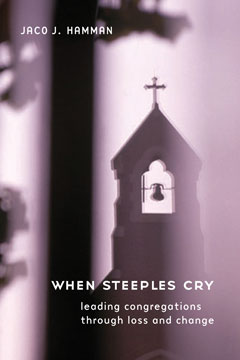HOME
"As a leader in your congregation you facilitate growth and bring change. You are called to empower your congregation to be the body of Christ. Inevitably, your call includes not only being with those who grieve and mourn, but introducing loss to your congregation. The face of change-as-loss is varied and always morphing into a new image: a congregation is thriving with rapid membership growth; a pastor leaves; a congregation commits to a building project; a church member dies; programs are introduced and then disappear; a congregation becomes an island in a sea of societal change. Your effectiveness and creativeness as an agent of growth and vitality for your congregation depends on your ability to facilitate the work of mourning." (Taken from the Introduction)
An overview
The first chapter, called “Grieving is the Gospel,” identifies
ministry as grief work in primarily two ways. Inwardly, you as a leader in
your Gospel community need to mourn disappointments and letdowns experienced
in your ministry. Sometimes people abandon you and other times your dreams
for the congregation end as if you suddenly woke up.
The second chapter identifies significant losses-through-change most Gospel communities experience. The good news is that God calls out leaders like you who can be responsive to your own grief and facilitative of your Gospel community’s mourning. The gospel or good news in grieving is the promise of new self-understanding and revitalization that is unlocked by doing the work of mourning. In the chapter called “All the church’s losses, all the church’s griefs,” I provide a framework by which you can recognize the diverse ways in which loss shows its face in your community. I name six losses common to most Gospel communities. In addition, this chapter describes the dynamics that are unleashed by your congregation’s experience of loss. By being attentive to these manifestations of grief, you prepare yourself and your congregation to do the work of mourning while avoiding the pitfalls of leading a congregation beyond their grief.
The third chapter, “Conversation-as-the-work-of-mourning,” describes the first intentional step in doing the work of mourning. The chapter aims at empowering you to facilitate conversation around the losses and changes that occurred in your congregation, thereby creating the space for your community-as-a-whole to do the work of mourning. The chapter shows formal and informal conversations within your congregation as lifegiving to the community. You will be encouraged to be curious about the stories that individuals can tell about themselves or about the congregation. The body of Christ needs to tell about its past, its present, and its future before a vision of the future can become reality.
Building upon the foundation of numerous conversations with individuals and groups, the fourth chapter nominates Sunday morning worship as a crucial event in facilitating the work of mourning in your congregation. “Communion-as-the-work-of-mourning” reveals how a worship experience can create the space for the work of mourning to occur. The elements within a worship service, ranging from the sermon to singing to serving communion, can invite your community to remember its past as it lives into a new identity. The work of mourning intensifies when our losses are named in the presence of God. A worship experience can become a truth-telling experience similar to that which we see within the Book of Lamentations and Psalms of Lament. These books give us a language of pain, fear, uncertainty, sadness, and sorrow, but also of gratitude and hope<em>a language seldom heard in sermons or in the music we use in worship.
The final chapter, “Compassion-as-the-work-of-mourning,” identifies compassionate ministries as important for two reasons: First, it further facilitates the work of mourning in your congregation, and second, it leads to revitalization. The good news when doing the work of mourning is that your congregation will receive a new self-understanding of what it means to be the body of Christ at this time and in its specific context. Compassionate ministries help your congregation to live into a new identity. It concretizes much conversation about a past, a present, and a future.
Contents
Acknowledgments
Introduction
Chapter 1 Grieving is the gospel
Chapter 2 All the church’s losses, all the church’s griefs
Chapter 3 Conversation-as-the-work-of-mourning
Chapter 4 Communion-as-the-work-of-mourning
Chapter 5 Compassion-as-the-work-of-mourning
Conclusion
When Steeples Cry is available at www.amazon.com or www.barnesandnoble.com
